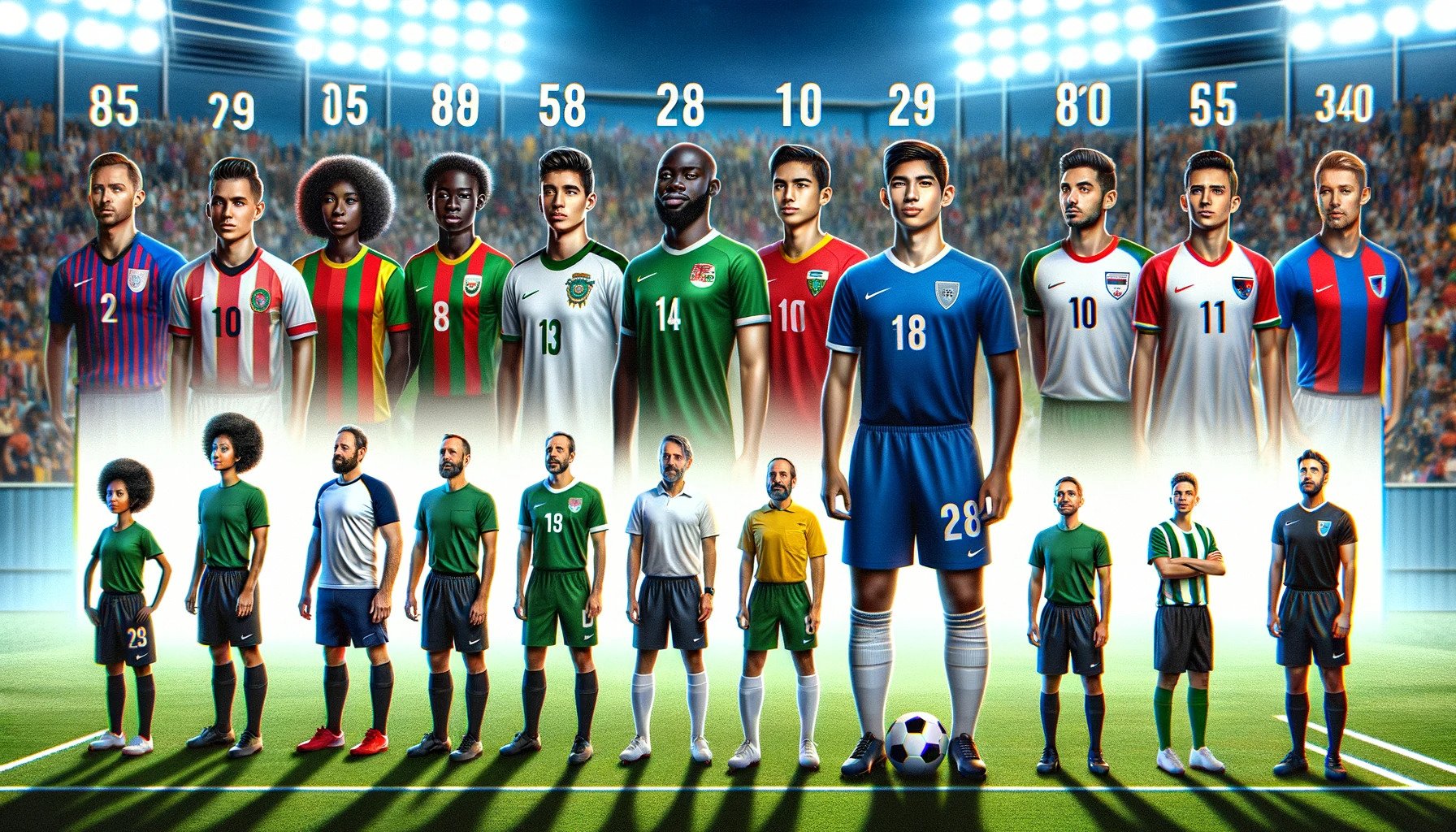Like many soccer enthusiasts, I’ve always been curious about the average height of soccer players and how it influences their positions on the field. Having played the sport at various levels, I’ve observed that short soccer players often occupy wide positions on the field. This observation aligns with my personal experience, where teams typically position their smaller, agile players as wingers or right- and left-backs. Their stature often lends itself to greater agility and speed, essential traits for these roles.
Reflecting on the broader landscape of soccer, it’s evident that the game has evolved over the years, and so have the physical attributes, specifically the height, of players. Soccer players today vary significantly in height, encompassing all ages, genders, and sizes. This diversity is a testament to the sport’s inclusivity and the importance of skill, technique, and strategy over mere physical traits. As someone deeply immersed in soccer, both as a player and a fan, I’ve come to appreciate these critical components.
In this blog post, I aim to provide valuable insights into how the average height of soccer players, both professional and female soccer players, has changed and the implications these changes have had on the game. Whether you’re a seasoned soccer player or just someone wondering about the dynamics of the sport, understanding the role of height can offer a new perspective on how the game is played and enjoyed.
Average Height Of A Professional Soccer Player
In my experience following the English Premier League, I’ve observed that the average height of a professional soccer player plays a significant role in their career trajectory. Typically, this average lies somewhere between the imposing heights of 5’11” to 6’2”.
However, this is not just about numbers; it reflects how height serves as an important factor in a player’s position and overall success in the game. But it’s crucial to note that height is not the sole determining factor. A player’s skill, technique, and tactical awareness at the professional level are pivotal in achieving success.
The general averages in height seen across different teams in the Premier League show variations, with some specific players standing out due to their unique physical attributes. As a long-time fan and a former player myself, I’ve come to appreciate how these height differences contribute to the diverse strategies and styles of play within the league, showcasing that success in soccer is a blend of physicality, skill, and mental acuity.
Average Height of Female Soccer Players

In the realm of women’s soccer, the average height of a female soccer player typically ranges from 5’5” to 5’7”. This contrasts with male soccer players, where heights can greatly vary. What I’ve learned through my involvement in the sport is that, unlike their male counterparts, female soccer players often tend to be shorter, yet this doesn’t hinder their prowess on the field. It’s fascinating to see how these athletes adapt their player’s position and level of play according to their physical attributes.
Notably, the heights of even famous female professional soccer players do not always have a direct correlation with their skills and abilities. As a fan and a former player, I’ve seen firsthand that listed heights of players aren’t always exact, but this variability in stature doesn’t necessarily impact their effectiveness as professional soccer players. This diversity in height, reflecting a range of playing styles and strengths, is what makes women’s soccer exceptionally dynamic and engaging.
Average Height in Soccer for Each Position
In my years of following soccer, both as a player and a coach, I’ve compiled a table providing insight into the average heights for each position on the field.
| Position | Average Height |
| Goalkeepers | 6 foot 2 inches (188 cm) |
| Defenders | 6 foot (183 cm) |
| Midfielders | 5 foot 11 inches (180 cm) |
| Strikers | 5 foot 11 inches (180 cm) |
This table offers an insightful glimpse into how the physical stature of players is aligned with their roles on the pitch. It’s interesting to note that while goalkeepers typically tower with their greater height, midfielders and strikers often share a similar height profile, balancing agility and reach.
As someone who has played in various positions, I’ve seen firsthand how height can influence a player’s role and effectiveness on the field, yet it’s the skill and strategy that ultimately determine their success in soccer.
Does Height Matter in Soccer?
Indeed, height serves as a determining factor in certain aspects of soccer, especially for taller players who often have an advantage in aerial challenges and set pieces. However, shorter players showcase advantages in dribbling, agility, and quickness, essential elements for maneuvering through tight defenses. It’s the combination of these physical attributes, along with technical ability, tactical awareness, and mental toughness, that crafts a successful soccer player.
Reflecting on the best players in the history of the sport, like Lionel Messi and Xavi Hernandez, who are on the shorter side, and Peter Crouch and Tim Howard, who are notably taller, it becomes clear that height is just one aspect of a player’s abilities and skills. Regardless of their sizes, players can excel in the game by leveraging their unique strengths and adapting to the demands of their roles on the field.
Advantages of Being Tall in Soccer
In the world of soccer, height can often be seen as an advantage, though it’s not the sole factor for success. As a former soccer coach, I’ve witnessed firsthand how tall soccer players benefit from their stature in various aspects of the game.
Heading
One of the key benefits of being tall in soccer is evident in heading. Taller players have a clear height advantage which makes it easier for them to win the ball in the air. This ability becomes crucial, especially in set-piece scenarios or when there’s space near the net. Taller defenders, for instance, can use their height to score goals and defend against aerial threats.
Leg Length
Another aspect where height plays a critical role is Leg Length. During the match, longer legs can help in controlling and winning the ball. This ability to reach the ball more easily on both sides of the pitch is a significant advantage. It’s not just about getting to the ball; it’s about using the body to its advantage and outmaneuvering opponents.
Strength
Strength is often overlooked in soccer but is a vital aspect where taller players typically have the upper hand. In my experience, taller soccer players are typically stronger, giving them less to worry about in physical duels. Shorter opponents often find themselves at a disadvantage due to less leverage against the stronger bodies of taller players.
Reach (Goalkeepers)
In the specific case of goalkeepers, height is undeniably a big advantage. Taller goalkeepers generally have better reach, enabling them to control the net from a farther distance and handle shots more effectively. Their ability to get a fingertip on the ball can be the difference between winning and losing a match. As such, it’s not uncommon to see goalkeepers being the tallest players on a team in the modern game.
Ideal Soccer Height
In the debate about the ideal height for a soccer player, there’s a general consensus that it falls between 5 feet 6 and 6 feet 2 inches tall. However, in soccer, no brackets are set for a player’s height. Players of different heights perform their roles quite fluently on the field. For instance, Messi, known for his short height, remains one of the biggest names in soccer. On the other end of the spectrum is Ronaldo, who, despite being taller, is celebrated as one of the greatest players.
Primarily, teams might prefer a player who is tall enough to vie in aerial duels, attributing to their pace and power in the game. This range of heights in top players illustrates that success in soccer isn’t limited by height but rather defined by skill and dedication.
Advantages of Being a Short Soccer Player
In the soccer world, there’s a unique set of advantages for short soccer players. Having played as a midfielder during my amateur soccer days, I’ve seen these benefits firsthand.
Speed
One notable advantage is speed. While there’s no evidence that short players are necessarily faster or quicker than taller players, they often have a bit of an edge when it comes to rapid action. This is especially true in soccer, where quick bursts of speed can drastically change the flow of the game.
Lower Center of Gravity
Another significant benefit is a Lower Center of Gravity. A soccer player with a lower center of gravity can easily maneuver across the pitch, which is especially advantageous since the ball is almost always on the ground. This ability often gives offenses a very hard time getting past these players and makes it harder for defenders to make a play.
Ball Control
Ball Control is an aspect where shorter players often excel. Being able to take shorter steps and maintain more touch on the ball allows for better control overall. In tight spaces, this skill becomes crucial and can outmaneuver taller opponents.
Short soccer players bring a dynamic aspect to their teams, using their physical attributes to their advantage. Their agility and ball-handling skills contribute significantly to the team’s strategy, demonstrating that height isn’t always the defining factor in a player’s capability on the field.
Positions of Tall Soccer Players
In soccer, the positions of tall soccer players are often pivotal to a team’s strategy. Most commonly, they are found as central defenders or strikers. A tall defender is able to compete effectively in all circumstances, especially in aerial duels where they won’t often lose. Similarly, a tall striker becomes an asset, considering their ability to serve as the team’s attack’s focal point.
They frequently play against each other in a match, creating a dynamic where height plays a crucial role. Whether it’s defending or leading the offensive line, their stature can significantly influence the game’s outcome.
Positions of Short Soccer Players
Similarly to their taller counterparts, short soccer players excel in their respective positions on the field. In most cases, these players thrive in wide positions across the soccer field. It’s mostly observed that teams’ wingers, along with right-backs and left-backs, tend to be smaller in stature.
This smaller build lends itself to agility and quick maneuvering, making them ideal for roles that require rapid changes in direction and pace. Their presence in these roles showcases the versatility and strategic deployment of players based on physical attributes in soccer, contributing uniquely to the team’s overall dynamics.
Player Stature and Soccer Strategies
As we delve into the various factors influencing a player’s performance, such as height, it’s also worth exploring different aspects of the game itself. Discover the intricacies of soccer terminology, including an in-depth explanation of ‘OG’ (Own Goal), in our feature What Does OG Mean in Soccer?
Frequently asked questions
What is the average height of a soccer player?
The average height of a soccer player typically ranges between 5 feet 7 inches (170 cm) and 6 feet 2 inches (188 cm), depending on the position and level of play.
What are the positions for the tall players?
Tall soccer players often play as central defenders or strikers, where their height gives them an advantage in aerial duels and set pieces.
What are the positions for short players?
Short soccer players usually excel in wide positions like wingers, right-backs, and left-backs, where agility and quick maneuvering are key.
What is the ideal soccer player’s height?
There is no strict ideal height for soccer players, but a range between 5 feet 6 inches and 6 feet 2 inches is often considered suitable, depending on the player’s role and skills.
Do taller players receive different treatment?
Taller players might receive different strategic roles or responsibilities on the field, especially in positions that benefit from height, but treatment largely depends on their skill set and the team’s tactics.
What is the average height of a man in soccer?
The average height of a male soccer player generally falls between 5 feet 9 inches (175 cm) and 6 feet 2 inches (188 cm).
What is the maximum height of a footballer?
There is no official maximum height for a footballer, but some of the tallest professional footballers have been around 6 feet 7 inches (201 cm) to 6 feet 8 inches (203 cm).

